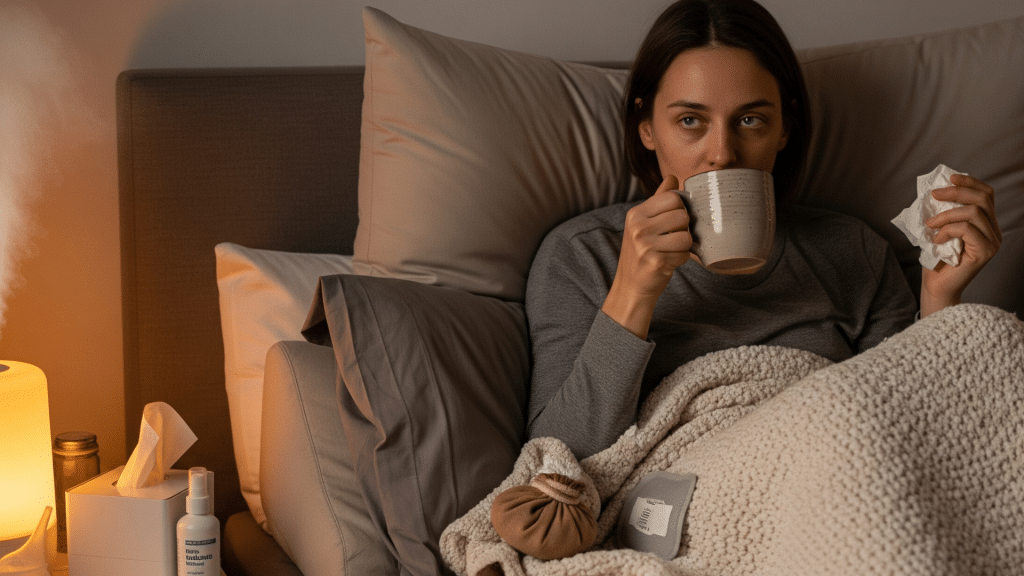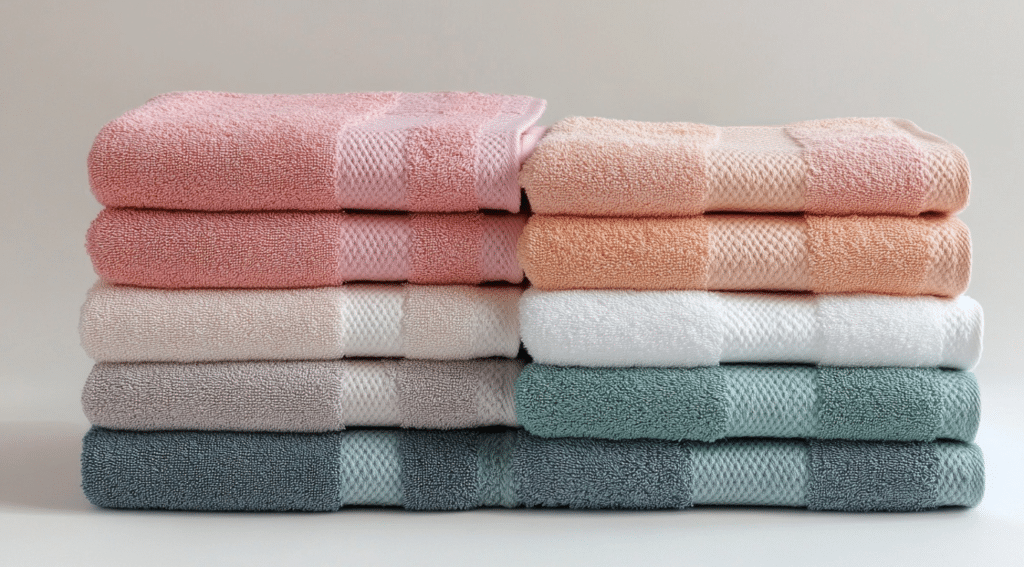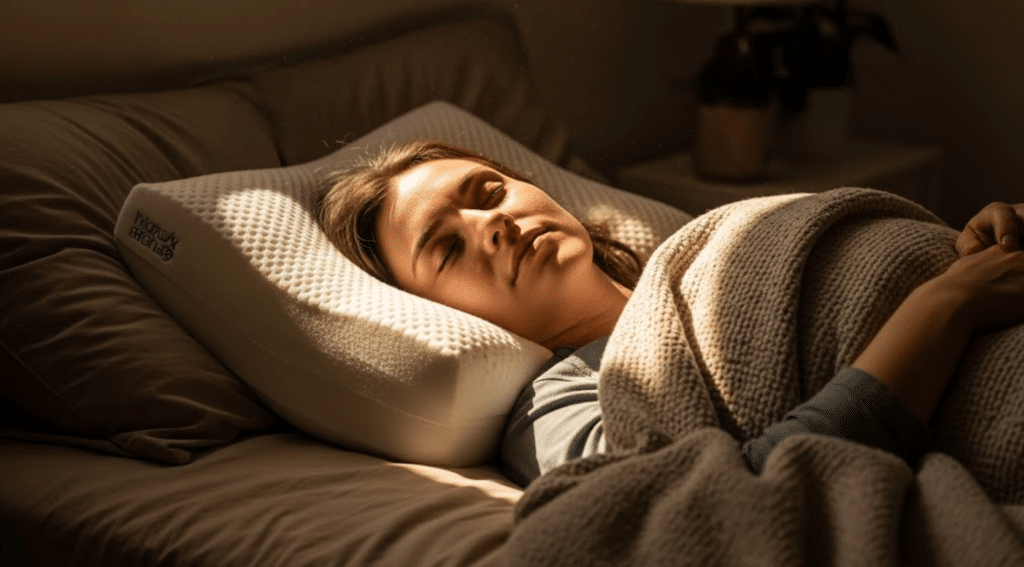I know how hard it is to fall asleep when your nose is blocked and you can’t breathe right. If you’re like me, you’ve probably searched for answers on how to sleep when congested without tossing and turning all night.
The good news is, a few small changes can make a big difference. By adjusting how you sleep and clearing your airways before bed, you can finally get the rest you need.
You’ll wake up feeling clearer, calmer, and more refreshed.
Understanding Nasal Congestion and Its Impact on Sleep
Nasal congestion occurs when your nasal passages become blocked or swollen due to mucus buildup, inflammation, or other factors like allergies or infections.
This can make breathing through your nose difficult, especially while lying down. It’s one of the main reasons people look for ways to sleep with a stuffy nose.
When congested, the body struggles to get adequate airflow, leading to disrupted sleep patterns and potential sinus pressure, making it harder to get the rest you need.
How to Sleep When Congested: Step-by-Step Guide
If you’re wondering how to sleep when congested, follow these simple steps to clear your nasal passages and get a better night’s sleep.
- Step 1: Drink warm tea or water with honey before bed to loosen mucus and make breathing easier. Staying hydrated helps thin mucus, preventing it from becoming thick and sticky.
- Step 2: Place a humidifier near your bed to keep the air moist and prevent nasal passages from drying out. The moisture helps soothe irritation and breaks down mucus, making it easier to breathe.
- Step 3: Sleeping with your head raised helps prevent mucus buildup and encourages sinus drainage. Use extra pillows or a wedge pillow to relieve pressure and improve airflow.
- Step 4: Apply nasal strips before bed to open up your nasal passages and reduce congestion. These strips gently pull apart your nostrils, making it easier to breathe throughout the night.
- Step 5: If needed, use over-the-counter decongestants or nasal sprays to reduce swelling in your nasal passages. Be cautious with nasal sprays, as long-term use may worsen congestion. Always consult a healthcare professional before use.
Tailored Solutions for Different Causes of Congestion
Understanding the cause of your congestion is key to finding the right solution for better sleep. Different types of congestion require different strategies to relieve discomfort and promote restful sleep.
Here’s a breakdown of specific solutions for allergy, cold, and sinusitis-induced congestion:
Allergy-Induced Congestion

Allergies can cause nasal congestion due to environmental allergens like dust, pollen, or pet dander. This often worsens at night.
- Use an Air Purifier: Place an air purifier in your bedroom to remove allergens from the air and improve your breathing.
- Take Antihistamines: Consider taking an antihistamine before bed to reduce allergic reactions and prevent the nasal passages from swelling.
- Keep Windows Closed: Keep windows closed, especially during allergy season, to prevent outdoor allergens like pollen from entering your room.
- Wash Bedding Regularly: Wash pillowcases, sheets, and blankets often to prevent the accumulation of dust mites and pollen.
Cold-Induced Congestion

Congestion due to a cold results from mucus buildup in the nasal passages. This makes breathing difficult and disrupts sleep.
- Stay Hydrated: Drink warm liquids such as water, tea, or broth to help loosen mucus and make it easier to breathe.
- Try Hot Drinks: Hot liquids soothe your throat, loosen mucus, and provide comfort before bedtime.
- Use a Humidifier: Place a humidifier near your bed to maintain moisture in the air, preventing your nasal passages from drying out.
- Rest and Boost Immunity: Adequate rest strengthens your immune system, helping your body recover faster from the cold.
Sinusitis-Induced Congestion
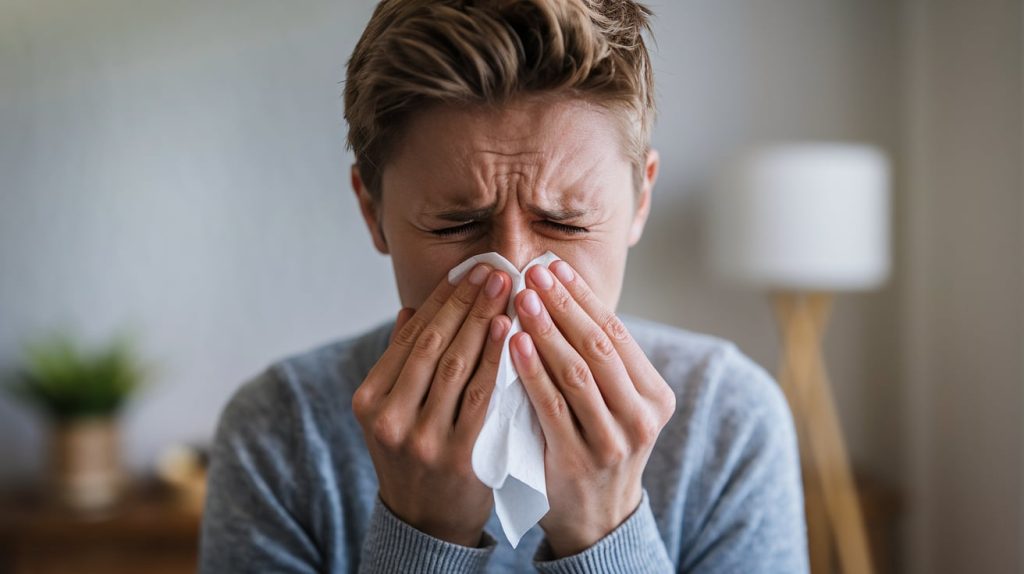
Sinusitis causes intense congestion due to inflammation and infection in the sinuses, making it especially difficult to sleep comfortably.
- Boost Your Head: Sleeping with your head raised encourages sinus drainage and reduces pressure in your sinuses.
- Apply Warm Compresses: Place a warm compress over your sinuses to relieve pressure and ease discomfort before bed.
- Nasal Irrigation: Use a Neti pot or saline spray to rinse out excess mucus and relieve sinus pressure.
- Use Decongestants: If recommended by a doctor, use decongestants to reduce nasal swelling and promote airflow.
How to Sleep with a Stuffy Nose: Effective Tips for Relief
How to sleep with a stuffy nose can be tough, but these methods help clear your airways and promote restful sleep.
Use a Humidifier to Ease Congestion
Moist air helps loosen mucus and soothe irritated nasal passages. Place a humidifier near your bed to keep the air moist. This helps loosen mucus and soothe irritated nasal passages, making it easier to breathe and reducing the discomfort caused by congestion.
Be sure to clean the humidifier regularly to prevent bacteria buildup, and consider adding essential oils like eucalyptus for additional relief.
Stay Hydrated to Thin Mucus
Drinking plenty of fluids, such as water, tea, or broth, helps thin mucus and keeps nasal passages moist. This makes it easier to breathe, especially when your nose is congested, allowing for easier breathing.
Staying hydrated also helps prevent dryness in your nasal passages and throat, which can worsen congestion. Aim for warm beverages, which are especially soothing when dealing with a stuffy nose before bed.
Nasal Strips for Quick Relief
Nasal strips help open up your nasal passages, providing immediate relief from congestion. Apply them across the bridge of your nose before bed to improve airflow while sleeping.
These strips gently pull apart your nostrils, allowing you to breathe more easily and reducing snoring and discomfort caused by nasal congestion.
Best Position to Sleep When Congested
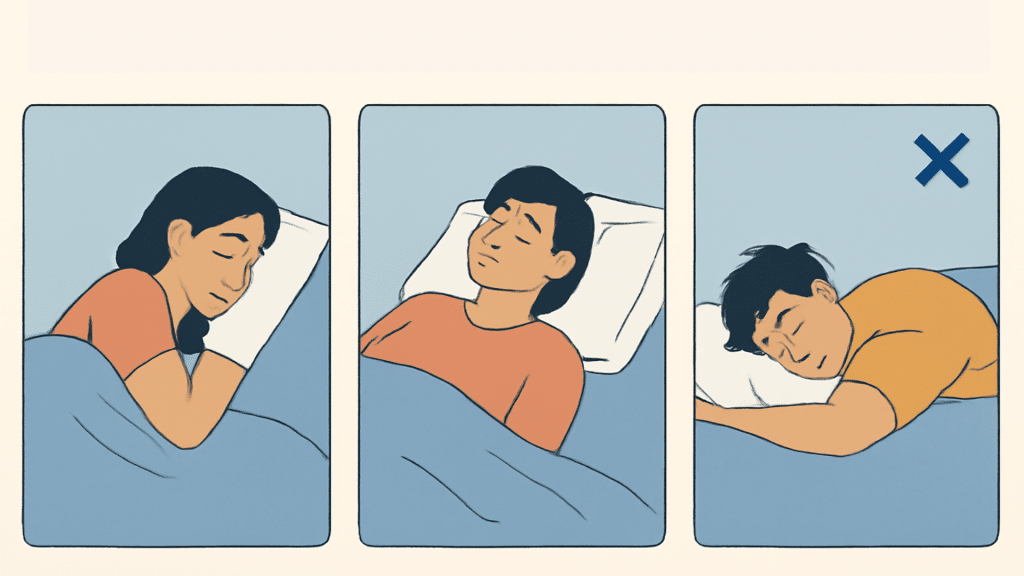
Finding the right sleep position when congested is essential for relieving discomfort and promoting sinus drainage. It helps keep your airways open and encourages mucus drainage.
Here are some effective positions that benefit from upgrading:
-
Sleep on Your Side: Sleeping on your side helps prevent mucus from pooling in your sinuses and keeps your airways open.
-
Sleep on Your Back with Your Head Raised: This position also promotes sinus drainage. Propping your head up with an extra pillow or wedge pillow encourages better airflow and reduces pressure in the sinuses.
-
Avoid Sleeping on Your Stomach: This position can increase pressure on your chest and nasal passages, making it harder to breathe and worsening congestion.
Long-Term Solutions for Chronic Congestion
Managing chronic congestion requires consistent strategies to reduce symptoms and improve long-term relief.
For allergy-induced congestion, use air purifiers regularly, take medications as prescribed, and maintain a clean environment with frequent cleaning routines.
Diet changes, such as avoiding mucus-producing foods like dairy, can help reduce congestion. Incorporating daily nasal irrigation using saline rinses or Neti pots can clear out mucus and prevent buildup.
For persistent issues, medical interventions, including surgery or other treatments, may be necessary to address the root cause of the congestion.
Additional Tips to Relieve Nasal Congestion While Sleeping
In addition to the tips already mentioned, here are a few more effective ways to relieve nasal congestion and make it easier to sleep with a stuffy nose:
Try Steam or a Hot Shower: A quick steam session helps open up your nasal passages, providing temporary relief from congestion. The warm moisture soothes your airways and loosens mucus, making it easier to breathe before you go to bed.
Massage Your Sinuses: Gently massage the sides of your nose and sinuses to reduce pressure and promote better airflow. This can help release any built-up mucus and improve sinus drainage, making it easier to sleep through the night.
Debunking Common Myths About Nasal Congestion and Sleep
There are many misconceptions about managing nasal congestion and its impact on sleep. It’s essential to dispel these myths to ensure you are using effective and scientifically backed strategies for relief.
| Myth | Fact |
|---|---|
| “Nasal sprays are safe for long-term use.” | Overusing nasal sprays can cause rebound congestion, worsening symptoms. Use only as directed and for short durations. |
| “Sleeping on your stomach clears your sinuses.” | Sleeping on your stomach can increase sinus pressure, compressing airways and making congestion worse. |
By addressing these myths, you can ensure that you’re following the most effective practices for managing nasal congestion during sleep. Always rely on evidence-based methods to achieve the best results.
When to Seek Medical Advice for Congestion
If your congestion persists or worsens, it could be a sign of a more serious condition, such as sinusitis, an allergy flare-up, or an underlying infection.
You should consult a doctor if your congestion lasts for more than 10 days or if you experience severe symptoms like headaches, facial swelling, or difficulty breathing.
Additionally, if the congestion seems to be linked to a chronic condition or infection, seeking medical advice is important to ensure proper treatment and prevent complications.
Conclusion
Now that you know how to sleep when congested, you can use these strategies to get the relief you need and enjoy a better night’s sleep.
If it’s staying hydrated, using nasal strips, or adjusting your sleep position, these tips will help clear your airways and reduce discomfort.
Don’t forget to try some of the long-term solutions, like using air purifiers for allergy-induced congestion. If your symptoms persist, be sure to consult a healthcare professional for further advice.
Want more tips on how to manage nasal congestion? Check out my other blogs for more helpful advice.

